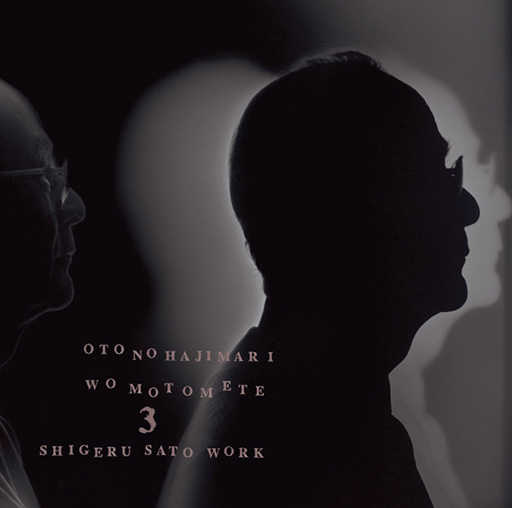
音の始源を求めて 3
佐藤 茂の仕事
<放送センター移転と大阪万博の頃>
The Beginnings of
Japanese Electroacoustic
Vol. 3
SHIGERU SATO works
- 《小懺悔》 諸井 誠 1967年
“Shosange” Makoto Moroi 1967 - 《ディスプレイ‘70-1》 柴田南雄 1969年
“Display‘70-1” Minao Shibata 1969 - 《電子音と声によるマンダラ》 黛 敏郎 1969年
“MANDARA with Source of Voice and Electric sound” Toshiro Mayuzumi 1969 - 《ボイセスカミング》 湯浅譲二 1969年
“Voices Coming” Joji Yuasa 1969 - 《ブロードキャスティング》 篠原 眞 1973年
“Broadcasting” Makoto Shinohara 1973
内容紹介
- 1.「小懺悔」諸井 誠
- 奈良・東大寺二月堂の「お水取り」で収録した法螺貝、高尾山の法螺貝、尺八、太棹三味線、長唄三味線を素材にして曲が構成されている。素材音のトレモロ、ビブラート効果が印象的な曲であり この効果を出すためにLAMが活用された。
- 2.「ディスプレイ'70-1」柴田南雄
- 打楽器音と電子音から成り立っているこの曲は、それぞれの素材音の特徴が出るように構成されており楽器音と電子音の対比を大切にした作品である。大阪万博会「日本政府館」の為に作られた。
- 3.「電子音と声によるマンダラ'69」黛 敏郎
- 前半は、非常に多くの正弦波を合成したクラスター音の中からフィルタとLAMで切り出して作られた小鳥の声のような音や、ホワイトノイズを素材にした低くうなるような音が使われている。後半は、生活の中の笑い声、浄瑠璃の笑いなど、種々の笑い声を主体に構成されている。それぞれの笑い声を変調し、フィルタで加工して作った音で制作されている。
- 4.「ボイセスカミング」湯浅譲二
- 3部構成。第1部、世界中の空間を飛び交う電話の音を素材にした作品。第2部、人の会話の中から無駄な言葉ばかりを並べてみたらどうか、というアイディアで作られている。第3部、人間の聴覚にどのくらいの時間差をもって音響信号を与えれば、音像の定位感が変わるのかという実験。
- 5.「ブロードキャスティング」篠原 眞
- 当時のNHK5波(テレビ、教育テレビ、ラジオ第一、ラジオ第二、NHK-FM)の、ある1日の放送をすべて録音し、コラージュした作品。6台の録音機と100本に上る6mmテープを準備。1時間ごとにテープを取り替えて連続録音した。当時の録音機には機器の間の同期機能がなく、時間のズレによる誤差を何百回とテープ編集で修正を重ねて作られた。
Introduction
- 1. “Small Confession” Makoto Moroi
- The works are composed of the Horagai, Takaosan’s Horagai, Shakuhachi, Futozao Shamisen, and Nagauta Shamisen recorded in Nara / Todaiji Nigatsudo’s “Omizutori”. The tremolo and vibrato effect of the material sound is impressive, and LAM was used to produce this effect.
- 2. “Display ‘70” Minao Shibata
- This work, which consists of percussion instrument sounds and electronic sounds, is designed to give the characteristics of each material sound, and is a work that emphasizes the contrast between instrument sounds and electronic sounds. It was created for the Osaka Expo “Japan Government Pavilion”.
- 3. “Mandala by Electronic Sound and Voice ‘69” Toshiro Mayuzumi
- In the first half, sounds like a bird’s voice created by cutting out a filter and LAM from a clustered sound composed of a large number of sine waves, and a low roaring sound made from white noise are used. The second half is mainly composed of various laughters such as laughter in daily life and laughter in Joruri. Each laughing voice is modulated and processed with a filter.
- 4. “Voices Coming” Joji Yuasa
- This work is divided into three parts. Part 1 is a work based on the sound of telephones flying around the world. Part 2 is made with the idea of trying to line up only useless words from a person’s conversation. And Part 3 is an experiment of how much time difference gives an acoustic signal to human hearing to change the sense of localization of the sound image.
- 5. “Broadcasting” Makoto Shinohara
- This is a collage of all NHK radio waves (TV, Educational TV, Radio 1st, Radio 2nd, NHK-FM) recorded at the time. Prepare 6 recorders and 100 rolls of 6mm tapes. The tape was changed every hour and recorded continuously. The recorder at that time did not have a synchronization function between devices, and it was made by correcting the error due to time gaps hundreds of times by tape editing.
BUY
- Official Online Shop
- https://sound3.buyshop.jp/items/72396699
- Amazon
- https://www.amazon.co.jp/dp/B07T9KY2X9/
- CDに関するお問い合わせ
- denshi-ongaku@sound3.co.jp
Manufacture Distribute by Sound 3 Co., Ltd. (P)2020
制作/有限会社 サウンドスリー
企画/大阪芸術大学音楽工学OB有志の会
Sound 3 Co., Ltd.
#404 Style House Ebisu 3-34-14 Ebisu Shibuya-ku Tokyo Japan zip 150-0013